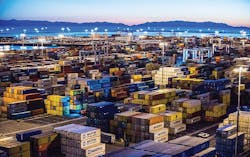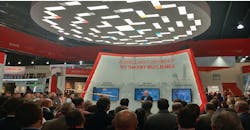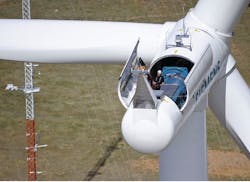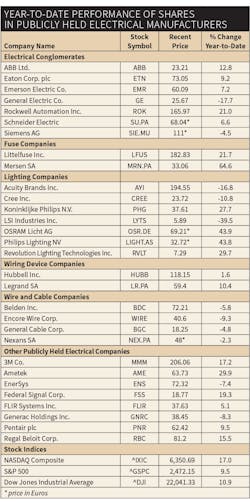Sponsored
The famed baseball philosopher Yogi Berra was quoted as saying, “You can observe a lot just by watching.” That’s certainly the case when you watch where the largest electrical manufacturers invest in acquisitions and new markets. While there’s been no shortage of interesting news stories and key market trends to consider over the past 12 months, Electrical Wholesaling’s editors believe the following five news stories and trends will drive much of the change in the electrical manufacturing community in the near future.
#1 The New GE: Betting Big on a More Digital Future
If you hear some folks muttering, “GE, we hardly know ‘ye anymore,” don’t be surprised. Lots of folks are talking about GE’s intentions to sell of both its industrial solutions and lighting businesses, and its bold move to rebuild itself around IoT solutions, launch the Current, powered by GE, business, build out its renewables business and digitize most of the rest of the country in some manner.
The transition has been far from painless. Long-time CEO Jeffrey Immelt has left the company after 16 years at the helm and Warren Buffett and his Berkshire Hathaway fund dumped about 10 million shares worth an estimated $315 million in 2Q 2017 according to SEC documents. When that news broke in early August, the stock took a hit.
Certainly, the confirmed reports of divestitures at GE add to the air of uncertainty. A recent Reuters report said ABB is talking with GE again about purchasing the industrial unit after their talks stalled in July, although for less than GE’s original price tag of $3 billion. GE is apparently entertaining the possibility of selling its industrial solutions business for a little over $2 billion according to four sources familiar with the negotiations. And industry chatter about the potential sale of the GE Lighting unit gained new momentum in June when Randy Reid of the EdisonReport obtained and posted an internal memo that the iconic lighting business was definitely up for sale.
Sentimentalists longing for the “old GE” can’t stop the changes, and some recent announcements for new projects offer some insight into the types of orders the company will be gunning for in the future. The Home Depot recently announced that it had selected Current, powered by GE, to support the expansion of its rooftop solar energy program and that it would be installing 30,000 GE solar panels on the roofs of 30 home centers. Current partnered with Home Depot on site selection, project implementation plans, financing and incentive capture for 20 solar installations in New Jersey, as well as 10 additional stores in Connecticut, Maryland and Washington, DC. The panels will generate 11.9 MW in total and reduce the electricity grid demand by an estimated 30 to 35 percent annually at each Home Depot store.
On the digital front, GE’s Transportation unit announced that less than a year since launching a digital solution to keep cargo flowing efficiently through America’s largest container port, the Port of Los Angeles, LA elected to expand the program to include all container terminals and shipping lines at the Port, in a deal worth $12 million.
“The Port of Los Angeles and GE Transportation have become the global leaders on trying to digitize the supply chain and bring efficiencies to the maritime industry,” said Weston LaBar, executive director of the Harbor Trucking Association, in a GE press release. “A trucking dispatcher may visit up to 40 websites a day just to coordinate cargo movement into the port complex. Having a single portal, a single reference point, will create new levels of efficiency that we’ve been seeking for a long time.”
#2 The Dreams of Connected Lighting Clash with the Financial Realities of a Sluggish Lighting Market
It’s easy to see how connected lighting will revolutionize the lighting industry as we now know it. Linking light sockets to the internet by providing them with IP addresses allows users to control them remotely and collect energy usage data and other relevant application information. And some companies are equipping their IP-enabled fixtures with additional sensors and cameras for security purposes and to measure moisture, temperature, noise, the presence of occupants and applications we haven’t even thought of yet.
But the billion-dollar question is how soon connected lighting may start creating entirely new revenue streams. EW’s editors analyzed the transcripts of the most recent quarterly reports of publicly held lighting companies, and two messages came across loud and clear: The fortunes of the commercial/industrial lighting market are still tied to the cyclical swings of the nonresidential construction market, and despite its industry-shaking potential, connected lighting hasn’t yet scratched the surface of its enormous potential out in the field and has relatively little penetration into real-world lighting applications.
Eaton Corp. has made huge strides in lighting over the past five years with its blockbuster $13 billion acquisition of Cooper Lighting in 2012, the largest in its history at the time, plus steady investment in its lighting portfolio. At a 2015 investor conference, Eaton said it expected to gain $800 million in additional lighting revenue by 2020. And while the company is all-in on connected lighting with solutions like its DLVP, LumaWatt Pro, WaveLinx and innovative PoE (Power over Ethernet) wiring solutions, right now it’s more of a medium-term/long-term play, according to a recent teleconference with investors.
Craig Arnold, the chairman and CEO for Eaton, told investors the company has accelerated its R&D investment in its Electrical Products segment. “Some of the spending will certainly fall into the category of you have to be ready, you have to be capable,” he told analysts on the call. “And then in others are places where we’re in the midst of really developing what we think are unique and compelling value propositions around digitization. Lighting is one great example of where we think today we have a real value to sell and we think we can ultimately be paid for it. But these are largely upfront investments in core technology and core capability that essentially will have paybacks more in the medium term than in the near term.”
Cree Inc., is another lighting manufacturer that was in early on connected lighting. One of its flagship products in this arena is SmartCast PoE, a scalable and open IoT-enabled platform that’s part of the Cisco Digital Ceiling framework ready for mass deployment and adoption.
Charles Swoboda, Cree’s chairman, president and CEO, also said it may take several quarters for new products, particularly specified or more technical products like SmartCast, to impact the bottom line. He told analysts in his company’s recent call to discuss its financial year results that, “In lighting, a new product is probably two, three, maybe four quarters from when you see a real significant uptick, especially if it has to be specified. If it’s specified, it could be six quarters. So I think C-Lite (a new line of fixtures aimed at electrical contractors) maybe has a better short term opportunity just because it’s more of a stock and flow product, but a lot of those new products at LightFair, you really won’t see the benefit until probably early 2018.”
Despite the long ramp-up for connected lighting, few would dispute that the market opportunity is immense. In May, Acuity Brands announced its new Atrius software platform, a scalable and secure platform that enables indoor positioning, asset tracking, space utilization, spatial analytics and energy management. Vernon Nagel, the company’s chairman, CEO and president, gave analysts a brief introduction to Atrius and how it will mesh with the company’s installed base of other connected lighting products in a recent conference call.
“Through Atrius, we will continue to provide and expand our comprehensive set of IoT business solutions, leveraging intelligent luminaires, lighting and building management controls, software platform services and development tools. These solutions deliver connectivity and intelligence to a space via an expansive network of smart LED lighting and controls and a software platform that gathers, unlocks and transforms raw data to enable a broad range of software solutions, addressing critical business challenges. Atrius solutions have already been deployed across nearly 60 million square feet of indoor spaces, leveraging more than 1 million sensors. Additionally, the installed base of the Acuity Brands’ network lighting systems encompassing more than 1 billion square feet will now be upgraded to a more multifunctional Atrius sensory network that can supply IoT data to this robust platform.”
#3 Manufacturers & Their ESCOs: A Marriage Made in Heaven or Distributor Hell?
Osram’s announcement this year that had acquired a Houston-based ESCO (energy service company), Maneri-Agraz, for its Osram Lighting Services Unit that already includes the Sylvania Lighting Services business, was a reminder that some electrical manufacturers are quite interested in pursuing energy savings performance contracts (ESPCs) in deals that may or may not include electrical distributors as local sources of supply.
Along with Osram and Sylvania, Eaton, Schneider, Philips and Siemens all have business units that target ESPCs. The federal government provides some truly gigantic ESPCs, many through its General Services Administration (GSA), which owns and leases over 376.9 million square feet of space in 9,600 buildings in more than 2,200 communities nationwide. As GSA says on its website, “In addition to office buildings, GSA properties include land ports of entry, courthouses, laboratories, post offices, and data processing centers.”
Ever think an electrical distributor may one day compete against Tesla for business? It could happen, as SolarCity, which Tesla owns, is among the 118 firms on the Department of Energy’s Qualified List of ESCOs that compete for this work. Also on this list are these electrical manufacturers mentioned earlier, as well as some very familiar other names like Facility Solutions Group (FSG); electric utilities like Baltimore Gas & Electric, Florida’s FPL Energy Services, ConEd Solutions, PEPCO; and HVAC manufacturers like Carrier, Honeywell and Johnson Controls.
With all that’s going on with the LED revolution and the retrofit of not only these government facilities but thousands of buildings run by schools and universities, hospitals, Fortune 500 companies and other building owners, electrical distributors, manufacturers and reps should analyze where they stand with these ESCOs and see what business partnerships they may be able to engineer.
#4 Scratching Beneath the Surface of Schneider’s $1.25 Billion Purchase of ASCO
With all the acquisitions that happen each year in the electrical market, it’s way too easy to get a bid jaded about “just another billion-dollar-deal.” Don’t make that mistake about Schneider’s purchase of ASCO, a blue-chip manufacturer of automatic transfer switches that will mesh beautifully with Schneider’s package of switchgear and distribution equipment and its mission to be the biggest provider of power for critical applications like hospitals, financial institutions and data centers, where a few seconds without power can mean the loss of life, billions of dollars or terabytes of irreplaceable data.
As Philippe Delorme, Schneider Electric’s executive VP of Building and IT explained to industry analysts when the company announced the acquisition, “A transfer switch is something pretty simple. In many critical applications, (like) data centers or hospitals, you need to make sure that you always have power on. So you will have your connection to the grid, of course, but you will have some backup power. It could be, in most of the cases, gensets, and you need a piece of technology to connect or to switch sources from the grid when the grid has a problem to that source of energy.
“That’s what ASCO is doing. And to make the long story very short, ASCO is the leader in North America in this technology.”
#5 Billion-Dollar Deals in Renewables – Good for the Environment and the Company Vault
Tesla’s $2.6 billion acquisition of SolarCity late last year was just one example of the big dollars some companies are spending on renewables these days. Siemens provided two others, with its recently closed acquisition of Gamesa for roughly $1.2 billion, one of the world’s largest wind turbine manufacturers, and its $4.6 billion purchase of Mentor Graphics, which provides engineering software for a wide range of industrial applications including wind farms.
A report at www.cleantechnica.com ranked Gamesa and Siemens at #4 and #5, respectively, at the time of the acquisition, after Vestas, GE and Goldwing. According to information on Siemens’ website, the new company, Siemens Gamesa Renewable Energy, will have a 69GW installed base worldwide, an order backlog of around $24 billion, and revenue of approximately $11.2 billion.
Along with its Gamesa and Mentor Graphics deals, Siemens AG also recently announced a joint venture with global power company AES Corp., Arlington, VA, to develop utility-scale, battery-based energy storage systems in a new company called Fluence. An Electrical Marketing report said, “AES and Siemens are currently ranked among the leading energy storage integrators worldwide by Navigant Research. Together, the two companies have deployed or have been awarded 48 projects totaling 463 MW of battery-based energy storage across 13 countries, including the world’s largest lithium-ion battery-based energy storage project near San Diego.”
Summary. While Electrical Wholesaling’s editors think the news stories and trends outlined in this article will be the most interesting to watch, you could easily make a case that all the activity in IoT around predictive analytics capabilities, like Schneider’s investment in its Ecostruxure platform, is right up there, too.
And on the acquisition front, it will be interesting to see what happens with the recent news that General Cable’s board is considering a potential sale of the company, and with ABB’s purchase of Bernecker + Rainer Industrie-Elektronik GmbH (BR), an Austrian designer of factory automation equipment with estimated annual revenues of about $600 million.








